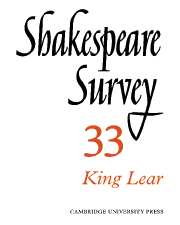Book contents
- Frontmatter
- King Lear: A Retrospect, 1939–79
- Some Conjectures on the Composition of King Lear
- The War in King Lear
- King Lear: Art Upside-Down
- ‘And that’s true too’: King Lear and the Tension of Uncertainty
- The Taming of the Shrew and King Lear: A Structural Comparison
- Medium and Message in As You Like It and King Lear
- Playing King Lear: Donald Sinden talks to J. W. R. Meadowcroft
- Hamlet’s Special Providence
- Antony and Cleopatra: ‘The Time of Universal Peace’
- Patterns of Motion in Antony and Cleopatra
- Theme and Structure in The Winter’s Tale
- Peter Street at the Fortune and the Globe
- English Actors at the Courts of Wolfenbüttel, Brussels and Graz during the Lifetime of Shakespeare
- Shakespeare at Stratford and the National Theatre, 1979
- The Year's Contributions to Shakespearian Study 1 Critical Studies
- 2 Shakespeare’s Life, Times, and Stage
- 3 Textual Studies
- Index
- Plate Section
Some Conjectures on the Composition of King Lear
Published online by Cambridge University Press: 28 March 2007
- Frontmatter
- King Lear: A Retrospect, 1939–79
- Some Conjectures on the Composition of King Lear
- The War in King Lear
- King Lear: Art Upside-Down
- ‘And that’s true too’: King Lear and the Tension of Uncertainty
- The Taming of the Shrew and King Lear: A Structural Comparison
- Medium and Message in As You Like It and King Lear
- Playing King Lear: Donald Sinden talks to J. W. R. Meadowcroft
- Hamlet’s Special Providence
- Antony and Cleopatra: ‘The Time of Universal Peace’
- Patterns of Motion in Antony and Cleopatra
- Theme and Structure in The Winter’s Tale
- Peter Street at the Fortune and the Globe
- English Actors at the Courts of Wolfenbüttel, Brussels and Graz during the Lifetime of Shakespeare
- Shakespeare at Stratford and the National Theatre, 1979
- The Year's Contributions to Shakespearian Study 1 Critical Studies
- 2 Shakespeare’s Life, Times, and Stage
- 3 Textual Studies
- Index
- Plate Section
Summary
Act III. [A heath.] The storm and king rage: the moment of greatest dramatic tension in King Lear comes precisely at the center of the play and remains the work’s fulcrum, yet where did Shakespeare get the idea for it? We have dozens of possible sources for Lear, yet none seems to yield sufficient clue. Lightning flashes twice in Shakespeare’s most certain source, The True Chronicle Historie of King Leir and His Three Daughters (?1594; 1605), where it frightens the messenger who is sent by Ragan to murder Leir and Perillus in the thicket, but the lightning is seen there by the three men as a sign of heavenly judgement, as flashes of cosmic omen, not as a raging storm within the broader kingdom or the little mind of man. Another likely source for Shakespeare, Book II, chapter 10 of Sir Philip Sidney’s Arcadia (1590), provided the playwright with a foul storm which allows Sidney to tell the story of the Paphlagonian king overheard by Pyrocles and Musidorus and now accepted as the basis for the subplot of Gloucester, Edmund, and Edgar. Sidney’s single Ciceronian sentence elongates the effectiveness of his description.
- Type
- Chapter
- Information
- Shakespeare Survey , pp. 13 - 26Publisher: Cambridge University PressPrint publication year: 1981



